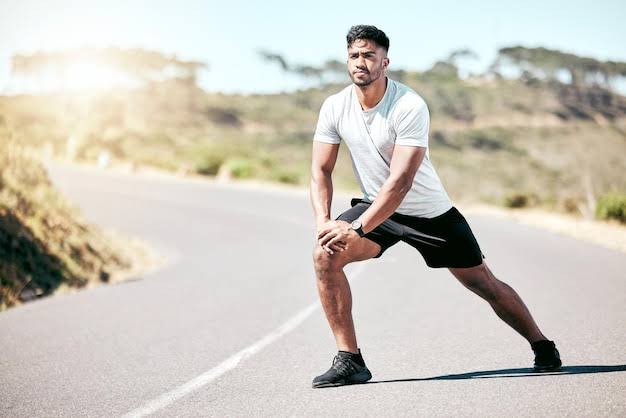Muscle soreness and fatigue can slow your progress and keep you off your game. Top athletes face the same challenges but follow proven recovery tactics to bounce back faster, train harder, and maintain peak performance. They blend science and strategy to support muscle recovery at every stage, from the moment training ends through deep sleep and beyond.
In this article, you will discover:
- How pros control inflammation and boost cellular repair
- Cutting-edge tools like cryotherapy, contrast baths, compression, and light or acoustic wave therapies
- Nutrition and supplements that fuel muscle rebuilding and support post exercise recovery
- Rest and active recovery routines that balance hormones and reduce soreness
- Technology and mind-body methods used to tailor recovery in real time
- Strategies for effective recovery after workouts
Ready to leave long rest days behind? For better recovery after workout, let’s begin by exploring the core mechanisms of pro-level muscle recovery.
Understanding Pro-Level Muscle Recovery
Recovery begins immediately after training, marking the start of post exercise recovery and muscle healing after workout. Immune modulation and hormone secretion work together to rebuild stronger fibers.
Inflammation Control
During the first phase of post-workout muscle recovery, neutrophils and macrophages move to damaged tissue. They release cytokines that clear debris and start repair. Elite athletes use targeted nutrition and rest protocols to modulate the NF-κB pathway. This approach controls inflammation without delaying muscle repair.
Cellular Repair
Satellite cells, also called muscle stem cells, activate after injury and fuse with damaged fibers via the mTOR signaling cascade. This triggers new protein synthesis essential for muscle recovery. Consuming 1.4 to 2.0 grams of protein per kilogram of body weight and supplementing with creatine monohydrate speeds glycogen replenishment and fiber regeneration.
Hormone Balance
Anabolic hormones like IGF-1 and growth hormone surge in deep sleep, driving tissue remodeling. Maintaining a healthy cortisol to testosterone ratio prevents excessive protein breakdown and supports sustained muscle growth. This balance is key for optimal recovery after working out.
Cutting-Edge Recovery Modalities
Elite athletes layer multiple recovery tools to speed healing, reduce soreness, and return to peak condition. These recovery modalities support post-workout muscle recovery from different angles.
Cryotherapy: Science and Benefits
Whole-body cryotherapy exposes the body to very low temperatures, usually between -110°C and -140°C, for two to three minutes. Rapid cooling triggers vasoconstriction, which helps control inflammation and reduces delayed onset muscle soreness (DOMS). When blood flow returns, it delivers fresh oxygen and nutrients to tissues.
- Analgesic effect from slowed nerve conduction
- Anti-inflammatory benefits from reduced cytokine activity
- Daily sessions possible during heavy training cycles
Localized cryotherapy units target specific areas for focused relief. Pros often combine whole-body and local treatments to manage overall fatigue and acute soreness.
Hydrotherapy & Contrast Baths
Hydrotherapy uses temperature shifts to stimulate circulation and clear metabolic waste. Contrast bath protocols include:
- Cold immersion (10°C to 15°C) for one to three minutes
- Warm immersion (38°C to 42°C) for one to three minutes
- Alternate for three to five cycles, ending on cold
This cycle leverages vasoconstriction and vasodilation to create a pump effect in blood vessels. The result is accelerated removal of lactic acid and other metabolites. Hydrotherapy also offers gentle pressure that soothes joints and muscles without extra load.
Pneumatic Compression Devices
Sequential pneumatic compression devices mimic the body’s own muscle pump. Normatec compression boots, for example, use dynamic air chambers to apply graduated pressure from ankle to thigh.
- Improved venous return and lymphatic drainage
- Reduced swelling and muscle fatigue
- Faster recovery between intense workouts
Typical sessions last 20 to 30 minutes. Athletes use compression devices immediately after training or competition to quickly shift from activity to recovery and recover from workout fatigue.
Red Light & Acoustic Wave Therapies
Photobiomodulation, or red light therapy, uses LED panels or laser diodes in the 600 to 900 nanometer range. A five- to ten-minute treatment per muscle group can boost mitochondrial ATP production, reduce oxidative stress and inflammation, and enhance tissue regeneration.
Acoustic wave therapy, also called radial shockwave therapy, delivers high-frequency pressure pulses. A standard session might use 2,000 to 3,000 pulses at three to five bars of pressure.
- Stimulates neovascularization in treated tissues
- Breaks down scar tissue and fibrosis
- Promotes collagen remodeling for stronger repair
Combined, red light and acoustic wave therapies add noninvasive recovery tactics to existing heat, cold, and compression methods. Using these tools together helps pros fine-tune recovery and sustain consistent training intensity.
Optimizing Nutrition and Supplementation
Effective post-exercise recovery starts with targeted nutrition. Athletes should focus on protein, carbohydrates, hydration, and evidence-based supplements to recover from workout stresses.
Protein for Repair
Aim for 1.4 to 2.0 grams of protein per kilogram of body weight each day. Total daily intake matters more than precise timing for most athletes.
- Whey, casein, and soy powders offer a full amino acid profile
- Spread protein evenly across meals for a steady supply
- For on-the-go muscle recovery, pros often use protein shots to meet their targets between sessions
- Leucine-rich foods trigger muscle protein synthesis via the mTOR pathway
Carbohydrates for Glycogen
Pairing carbs with protein post workout optimizes glycogen restoration, which is vital for post-workout muscle recovery.
- Consume 0.8 to 1.0 grams of carbohydrates per kilogram of body weight
- Choose high-glycemic sources like rice, white bread, or sports gels for rapid uptake
- Adjust carb intake based on training intensity and personal goals
Hydration Strategies
Fluids and electrolytes are key for nutrient delivery and muscle function during recovery after working out.
- Replace 1.5 liters of fluid for every kilogram of body weight lost during exercise
- Include sodium and potassium to support fluid balance
- Use water, electrolyte mixes, or natural options like coconut water
Advanced Supplements
Add these recovery tactics to your plan:
Creatine Monohydrate
- Typical dose: 3 to 5 grams per day
- Supports ATP regeneration and strength gains
- Reduces exercise-induced inflammation and aids glycogen replenishment
Tart Cherry and Omega-3
- Tart cherry extracts reduce muscle soreness and inflammation
- Omega-3 fatty acids support cell membrane repair and modulate cytokine activity
A balanced diet of fruits, vegetables, lean proteins, whole grains, and healthy fats ensures you get the micronutrients needed for effective muscle healing after workout.
Sleep, Rest, and Active Recovery
Pro athletes know recovery after workouts extends beyond the gym. Combining low-intensity movement with targeted rest strategies speeds repair and lowers soreness. These approaches work together to support protein synthesis and reduce delayed onset muscle soreness.
Active Recovery Activities
These low-intensity exercises help athletes recovering after a workout maintain readiness and reduce stiffness.
Light Cardio
Perform 20 to 30 minutes of walking, easy cycling, or swimming on rest days. This increases blood flow, flushing out metabolic byproducts without adding load.
Foam Rolling & Percussive Therapy
Daily foam rolling relieves tightness in quads, glutes, and hips. Complement it with a percussive device like a Theragun, applying 30 seconds per region to break up knots and boost circulation.
Yoga & Stretching
Incorporate gentle yoga flows that focus on hip and shoulder mobility. Hold each stretch for 30 to 60 seconds to enhance flexibility, support myofascial release, and calm the nervous system.
Power of Sleep and Rest
Optimal Sleep Duration
Aim for 7 to 9 hours of sleep each night. During deep rest, insulin drives amino acids into muscle cells and growth hormone peaks, both critical for overnight protein synthesis and tissue rebuilding.
Sleep Environment & Rituals
Set a consistent sleep schedule in a cool, dark, and quiet bedroom. Limit electronics before bed, cut caffeine after lunch, and follow a calming routine like light reading or herbal tea to ensure restorative rest and improve recovery after workout.
Personalized Recovery with Technology
Elite athletes leverage wearable sensors to monitor heart rate variability (HRV), muscle oxygen, and sleep in real time. Inertial sensors and bioimpedance devices track movement quality and tissue hydration. This data highlights fatigue and inflammation, guiding smarter recovery tactics.
AI-Driven Recovery Protocols
AI-driven apps analyze accelerometer, HRV, and skin temperature inputs to generate customized cooldown routines, stretching sequences, and nutrition plans. Machine-learning models compare user metrics against recovery targets to recommend optimal rest or active recovery steps. Some apps also adjust post-workout macronutrient targets based on recovery status.
Real-Time Insights and Alerts
Custom dashboards send alerts when recovery markers fall outside ideal ranges. Push notifications prompt protocol tweaks to maintain progress. Some platforms sync with Bluetooth massage guns or compression boots to automate session settings.
Mind-Body Strategies for Enhanced Recovery
Pro athletes pair physical protocols with mental practices to reduce stress and boost repair. These mind-body methods enhance recovery after working out by engaging the nervous system.
Meditation
Short mindfulness sessions lower cortisol and shift the body into rest and digest mode. Practicing 10 to 15 minutes of guided meditation daily can reduce stress hormones and improve immune response needed for muscle recovery.
Breathwork
Diaphragmatic breathing raises parasympathetic tone and boosts oxygen delivery. Use 4-7-8 breathing cycles to slow heart rate, calm nerves, and support tissue repair processes.
Visualization
Guided imagery primes neuromuscular pathways and clarifies recovery goals. Spend 5 minutes picturing strong, repaired muscle fibers to sharpen focus and potentially speed healing.
Conclusion
Faster muscle recovery is not about luck. It results from a strategic blend of science, tools, nutrition, rest, technology, and mind-body practices. By adopting the same protocols that elite athletes use, you can reduce soreness, rebuild muscle more quickly, and train with greater consistency.
Key takeaways:
- Inflammation control and cellular repair set the foundation for stronger muscles
- Cryotherapy, contrast baths, compression, red light, and acoustic wave therapies address soreness from multiple angles
- A balanced diet rich in protein, carbohydrates, and targeted supplements fuels repair and supports post exercise recovery
- Active recovery, quality sleep, and rest rituals support hormone balance and tissue remodeling
- Wearable tech and AI tools provide data-driven guidance to help you recover from workout stress in real time
- Meditation, breathwork, and visualization calm the nervous system and enhance post-workout muscle recovery
Putting it all together gives you a complete playbook for faster, more reliable recovery. Start layering these methods into your routine and watch both your training and performance reach new levels. The secret is out, now make it your advantage.






